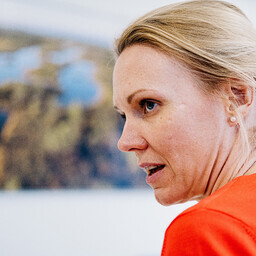Eesti ei täida metsanduses ja maakasutuses Euroopa Liidus kokku lepitud
kliimaeesmärke
aastateks 2021-2025. Seetõttu peab Eesti 2028. aastal ostma vähemalt kümnete miljonite eurode eest
heiteühikuid
. Riik veel selle kuluga ei arvesta, kuna seda on keeruline prognoosida. Loodetakse, et reeglid võivad muutuda.
kliimaeesmärke
Tõlge fraasile: kliimaeesmärke
EN
climate targets
heiteühikuid
Tõlge fraasile: heiteühikuid
EN
emission units
Iga riik peab täpselt arvestama, kui palju
kasvuhoonegaase
heidetakse. Lõplikud numbrid saame hiljem. Praegu arvatakse, et 2027. aastal saame selge pildi 2025. aasta heitmetest. Euroopa riikidel on mure, et praegune metoodika ei võta arvesse kõiki looduses toimivaid muutusi. Näiteks viimasel ajal on saginenud
looduslikud häiringud
, mis tulenevad kuumalainetest, üleujutustest ja kahjuritest.
kasvuhoonegaase
Tõlge fraasile: kasvuhoonegaase
EN
greenhouse gases
looduslikud häiringud
Tõlge fraasile: looduslikud häiringud
EN
natural disturbances
Mitmed riigid soovivad Euroopa Komisjoniga rääkida reeglite muutmise üle. Praegu uut kokkulepet ei ole. Kliimaminister Yoko Alender ütles aasta tagasi, et kulu riigile võib olla 24–48 miljonit eurot. Riik ei ole selle kuluga arvestanud, kuna läbirääkimised on veel käimas. Lisaks kliimamuutustele mõjutab olukorda ka sõda Ukrainas.
Enne, kui ei ole selge, kuidas erinevaid elemente arvesse võtta, ei saa prognoosida puudujääku. Järgmise aasta jooksul võib olukord selgemaks saada. Kui reegleid ei muudeta, siis 2028. aastal võib kulu olla suur. Metsanduse ja maakasutuse puudujääk võib lisaks transpordisektorile suurendada kulusid.
Kui reeglid ei muutu, siis kuluprognoos ei muutu. Kliimaministeeriumi hinnangul võib kulu olla 24–48 miljonit eurot. Kuid Soome hinnangul võib ühiku hind olla palju kõrgem. Kui Eesti kasutaks sama hinda, siis kulu võiks olla 70–170 miljonit eurot. Riik peaks kaaluma halvemat stsenaariumit.
Erinevad riigid hindavad ühiku hinda väga erinevalt. Fookus peaks olema investeeringutel, mis on
keskkonnale kasulikud
. Euroopa Liidu eesmärk ei ole riike trahvida, vaid hoida keskkonda ja aidata majandust. Komisjon soovib leida lahendusi muutuste toomiseks.
keskkonnale kasulikud
Tõlge fraasile: keskkonnale kasulikud
EN
beneficial to the environment
Komisjon ei saa reegleid muuta, seda saavad teha ainult riigid koos. Mõned riigid võivad saada palju raha kliimaeesmärkide täitmise eest. Need riigid võivad olla väga huvitatud praegustest reeglitest. Saksamaal on metsanduse ja maakasutuse sektoris ülejääk. Enamik riike aga maadleb muredega, kuidas arvesse võtta muutusi maakasutuses.
Euroopa Liidus lepitakse kokku kliimaeesmärgid kümneaastaste etappide kaupa. Nüüd küsitakse spetsiifiliselt, kuidas eesmärke täita. Metsandus ja maakasutus on tulevikus kliimaprobleemide lahendamise võtmevaldkond. Komisjon soovib leida lahendusi, mis oleksid pigem
porgand
kui
piits
. Metoodika ja reeglite osas on suur läbirääkimisruum.
porgand
Tõlge fraasile: porgand
EN
carrot
piits
Tõlge fraasile: piits
EN
stick
On teoreetiline võimalus, et järgmisel aastal selgub, et läbirääkimised ei ole viinud kuhugi ja puudujääk on palju suurem. Praegu on olukord veel ebaselge, kuid on suur kindlustunne, et erinevaid mõjusid hakatakse adekvaatselt arvesse võtma.
Estonia fails to meet the agreed climate targets in forestry and land use for 2021-2025 within the European Union. As a result, Estonia must purchase emission units worth at least tens of millions of euros by 2028. The state has not yet accounted for this cost, as it is difficult to predict. It is hoped that the rules may change.
Each country must accurately account for greenhouse gas emissions. Final figures will be available later. Currently, it is estimated that by 2027, we will have a clear picture of the 2025 emissions. European countries are concerned that the current methodology does not account for all natural changes. For example, natural disturbances caused by heatwaves, floods, and pests have become more frequent recently.
Several countries wish to discuss changing the rules with the European Commission. No new agreement has been reached yet. Climate Minister Yoko Alender said a year ago that the cost to the state could be 24–48 million euros. The state has not accounted for this cost, as negotiations are still ongoing. In addition to climate change, the war in Ukraine also affects the situation.
Before it is clear how to account for various elements, the deficit cannot be predicted. The situation may become clearer within the next year. If the rules are not changed, the cost in 2028 could be significant. The deficit in forestry and land use, in addition to the transport sector, may increase costs.
If the rules do not change, the cost forecast will not change either. According to the Ministry of Climate, the cost could be 24–48 million euros. However, Finland estimates that the unit price could be much higher. If Estonia uses the same price, the cost could be 70–170 million euros. The state should consider the worst-case scenario.
Different countries assess the unit price very differently. The focus should be on investments that are beneficial to the environment. The EU's goal is not to penalize countries but to protect the environment and support the economy. The Commission seeks to find solutions to bring about changes.
The Commission cannot change the rules; only the countries together can do so. Some countries may receive a lot of money for meeting climate targets. These countries may be very interested in the current rules. Germany has a surplus in the forestry and land use sector. Most countries, however, are grappling with how to account for changes in land use.
In the EU, climate targets are agreed upon in ten-year stages. Now, the question is specifically how to meet these targets. Forestry and land use will be key areas for solving climate problems in the future. The Commission seeks to find solutions that are more carrot than stick. There is significant room for negotiation regarding methodology and rules.
There is a theoretical possibility that next year it will become clear that the negotiations have not led anywhere and the deficit is much larger. Currently, the situation is still unclear, but there is great confidence that various impacts will begin to be adequately accounted for.

